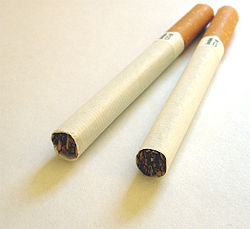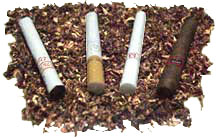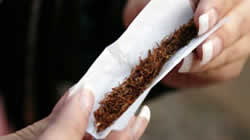Difference between revisions of "Cigarette"
(→Manufacture and ingredients) |
(→Sale) |
||
| (3 intermediate revisions by one user not shown) | |||
| Line 36: | Line 36: | ||
many cigarettes as possible using the least amount of raw materials as possible. | many cigarettes as possible using the least amount of raw materials as possible. | ||
| − | [[Image:Hand- | + | [[Image:Hand-rolled_cigars.jpg|right|Hand-rolled cigarette]] |
The most common usage of the cigarette is tobacco smoke delivery. The second most common usage of the cigarette is for | The most common usage of the cigarette is tobacco smoke delivery. The second most common usage of the cigarette is for | ||
| Line 64: | Line 64: | ||
which hit the market in the winter of 1973-1974 and whose ads used the slogan, "How can anything that looks so wild taste so | which hit the market in the winter of 1973-1974 and whose ads used the slogan, "How can anything that looks so wild taste so | ||
mild". | mild". | ||
| + | |||
| + | [[Image:Smoking_kills.jpg|left]] | ||
The sale of cigarettes and other tobacco products to minors under 18 is now prohibited by law in all fifty states of the | The sale of cigarettes and other tobacco products to minors under 18 is now prohibited by law in all fifty states of the | ||
Latest revision as of 11:27, 6 January 2010
A 'cigarette' is a tobacco product that is manufactured out of cured and finely cut tobacco leaves, which is rolled or stuffed into a paper-wrapped cylinder (generally less than 120 mm in length and 10 mm in diameter). The cigarette is ignited at one end and allowed to smoulder for the purpose of inhalation of its smoke from the other (usually cigarette filtered) end, which is inserted in the mouth. They are sometimes smoked with a Cigarette holder. The term cigarette, as commonly used, typically refers to a tobacco cigarette, but can apply to similar devices containing other herbs, such as cannabis. All tobacco products have been medically proven to considerably shorten lifespans. Most Western and several Eastern countries have large health warnings printed on the front and back of packets to warn of the effects of smoking.
A cigarette is distinguished from a cigar by its smaller size (hence the name), use of processed leaf, and paper wrapping; cigars are typically composed entirely of whole leaf tobacco. Cigarettes were largely unknown in the English-speaking world before the Crimean War, when British soldiers began emulating their Ottoman Empire comrades, who resorted to rolling their tobacco with newsprint.
Manufacture and ingredients
In practice, commercial cigarettes and cigarette tobaccos rarely contain pure tobacco. Manufacturers often use a tremendous variety of additives for a number of purposes, including maintaining blend consistency, improving perceived blend quality, as preservatives and even completely changing the organoleptic qualities of the tobacco smoke. While this is true for many brands of cigarettes, in Canada, the major cigarette brands all contain 100% natural virginia leaf - No Additives. Some cigarettes (known as kretek, clove cigarettes, or simply cloves) have cloves blended with the tobacco. This is done to enhance the smoker's pleasure by numbing the mouth and lungs and providing a mild euphoric effect. Lower-quality clove cigarettes simply have a clove essence added to the tobacco.
In addition to additives, cigarette tobaccos, especially lower-quality blends, are often highly physically processed. During the original processing of leaf for cigarettes, the leaves are deveined, and the lamina is shredded or cut. Since the leaf is relatively dry at this point, these processes result in a significant amount of tobacco dust. Manufacturing operations have developed procedures for collecting this dust and remaking it into usable material (known as reconstituted sheet tobacco).
The removed leaf midveins, which are unsuitable for use in cigarettes in their natural state, were historically discarded or spread on fields, because of their high nitrogen content. Procedures have been developed, however, to "expand" the stems, and process them for inclusion in the cigarette blends. All these procedures allow cigarette manufacturers to produce as many cigarettes as possible using the least amount of raw materials as possible.
The most common usage of the cigarette is tobacco smoke delivery. The second most common usage of the cigarette is for marijuana smoke delivery. The hand-rolled cigarette is the most common form of marijuana cigarette. Marijuana users will usually twist the ends of the cigarette to prevent fine cut marijuana buds from falling out. Tobacco users who roll their own cigarettes, however, will usually not twist the cigarette at the ends; hand rolling tobacco is made in strands so it doesn't have a tendency to fall out.
Some cigarette smokers roll their own cigarettes by wrapping loose cured tobacco in paper; most, however, purchase machine-made commercially available brands, generally sold in small cardboard packages of 10 or 20 cigarettes in the United States and United Kingdom or 25 in Canada. Commercial cigarettes usually contain a cellulose acetate or cotton filter through which the smoker inhales the cigarette's smoke; the filter serves to cool and supposedly clean the smoke.
Recently, cigarette rolling machines have become increasingly popular. One can purchase tobacco in pouches or cans, usually at a fraction of the price of what one would pay for the same amount pre-rolled. One can get a rolling machine that makes filterless, or straight cigarettes, or one can purchase a machine that packs the tobacco into a pre-rolled form with a filter. These filtered papers usually come in boxes of 200, while unfiltered papers will come in packs ranging from 12 to 64, and some contain even more.
Sale
Before the Second World War many manufacturers gave away collectible cards, one in each packet of cigarettes. This practice was discontinued to save paper during the war, and was never generally reintroduced. During the second world war they gave out free cigarettes to the soldiers and citizens. On April 1, 1970 President Richard Nixon signed the Public Health Cigarette Smoking Act into law, banning cigarette advertisements on television in the United States starting on January 2, 1971. However, some tobacco companies attempted to circumvent the ban by marketing new brands of cigarettes as "little cigars"; examples included Tijuana Smalls, which came out almost immediately after the ban took effect, and Backwoods Smokes, which hit the market in the winter of 1973-1974 and whose ads used the slogan, "How can anything that looks so wild taste so mild".
The sale of cigarettes and other tobacco products to minors under 18 is now prohibited by law in all fifty states of the United States. In Alabama, Alaska, New Jersey, Suffolk and Onondaga Counties in New York, and Utah the statutory age is 19, and legislation was pending as of 2004 in some other states, including California, to raise the age to 19, or even 21 in some cases. In Massachusetts, parents and guardians are allowed to give cigarettes to minors, but sales to minors are prohibited. Similar laws exist in many other countries as well. In Canada, most of the provinces require smokers to be 19 years of age to purchase cigarettes (except for Quebec, Saskatchewan, Manitoba and Alberta, where the age is 18). However, the minimum age only concerns the purchase of tobacco, not use. Alberta, however, does have a law which prohibits the possession or use of tobacco products by all persons under 18, punishable by a $100 fine. Australia has a nation-wide ban on the selling of all tobacco products to people under 18.
In the UK, cigarettes can legally be sold only to people aged 18 and over. However it is not illegal for people under this age to buy (or attempt to buy) cigarettes, so only the retailer is breaking the law by selling to under 18s. Most countries in the world have a legal smoking age of 18. One notorious exception is Switzerland, where the age is 16 whereas a country such as Turkey, which has one of the highest percentage of smokers in its population, has a legal age of 18. In other countries, such as Egypt, however, there is no legal smoking age at all.
In Sri Lanka it is prohibited to sell cigarettes to people aged below 21, and the sellers are adviced to verify the age if suspectable. Since the advertising of tobacco products is also illegal, cigaterette vendors display a sign board that they do not sell tobacco products to anyone under 21, and to cooperate the vendor to verify the age; which implies that they have tobacco products for sale. In Sri Lanka British American tobacco companey market most of the tobacco products.
However, while bans stand in most countries for sales to minors, it is still common for merchants to disregard such laws as they are tough to enforce. Often the profits from selling cigarettes to minors illegally are much greater than the fines paid out in very infrequent times when they are caught. Some police departments in the United States occasionally send a clearly underage child into a store where cigarettes are sold, and have the child attempt to purchase cigarettes. If the vendor sells them to the minor, the store is issued a fine. This is by far the most common way in which cigarette vendors are caught when they sell cigarettes to minors.
Online cigarette stores
Online stores have recently appeared that offer foreign cigarettes to internet buyers. As many jurisdictions place high taxes on tobacco sales, these could be seen as an effort to avoid paying duty or taxes.
Some online cigarette stores exist to sell tax-free cigarettes inside one's own country of residence as well. The legality of these stores is being questioned currently in the United States. Federal lawmakers contend that these stores are clear tax evasions. Recently in Michigan, several online stores have been subpoenaed by the state for the names and addresses of customers. The state has reportedly been sending out fines for each package purchased, contending tax evasion over Michigan's $2-a-pack law.
This same action has also taken place in Wisconsin after the Wisconsin Department of Revenue received a list of several thousand buyers in that state from an online cigarette merchant. However, the effort to collect on the taxes from the listed residents was stopped by order of Governor Jim Doyle a few days later.
Visa allow online cigarette stores to accept payment by credit-card.




